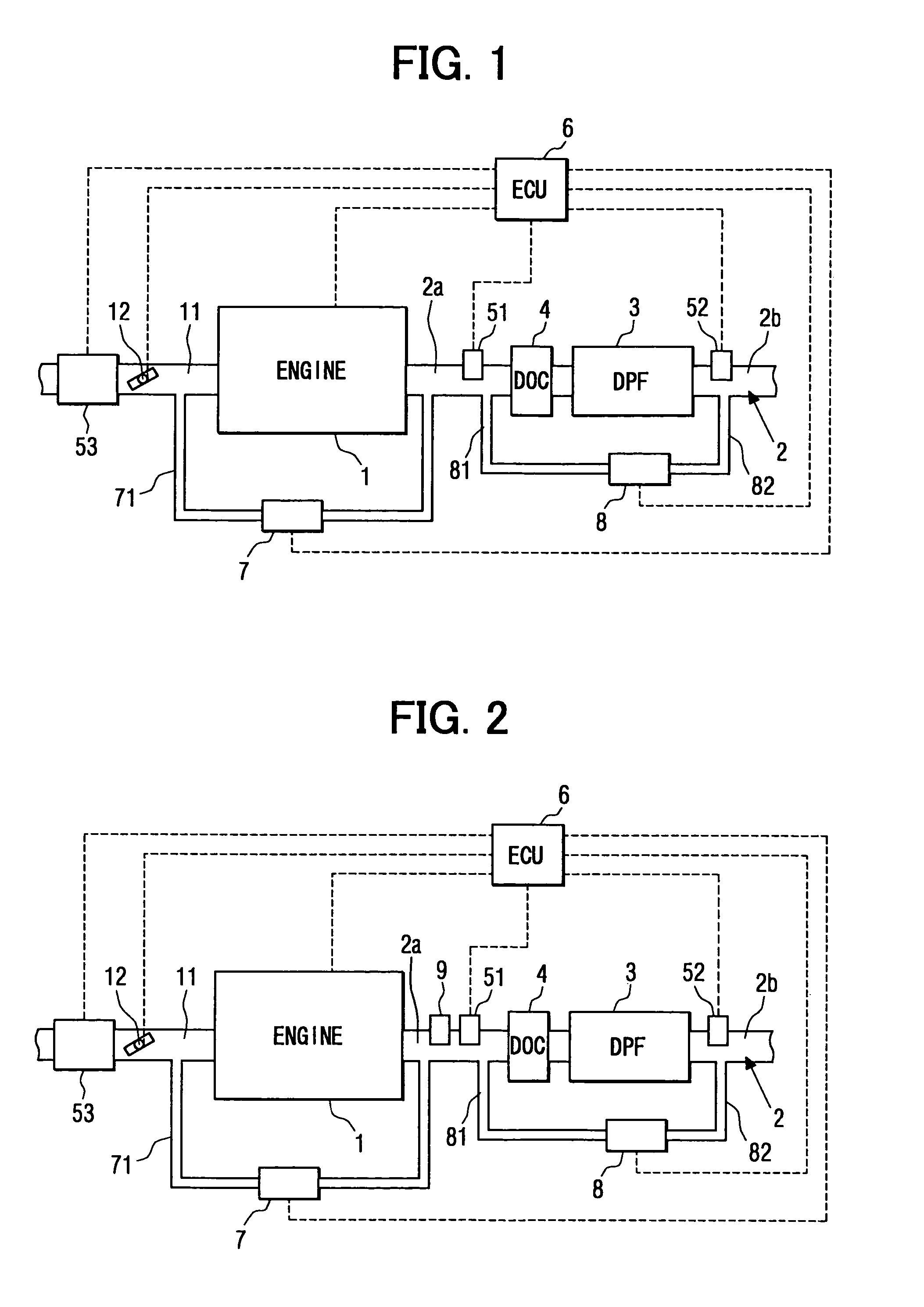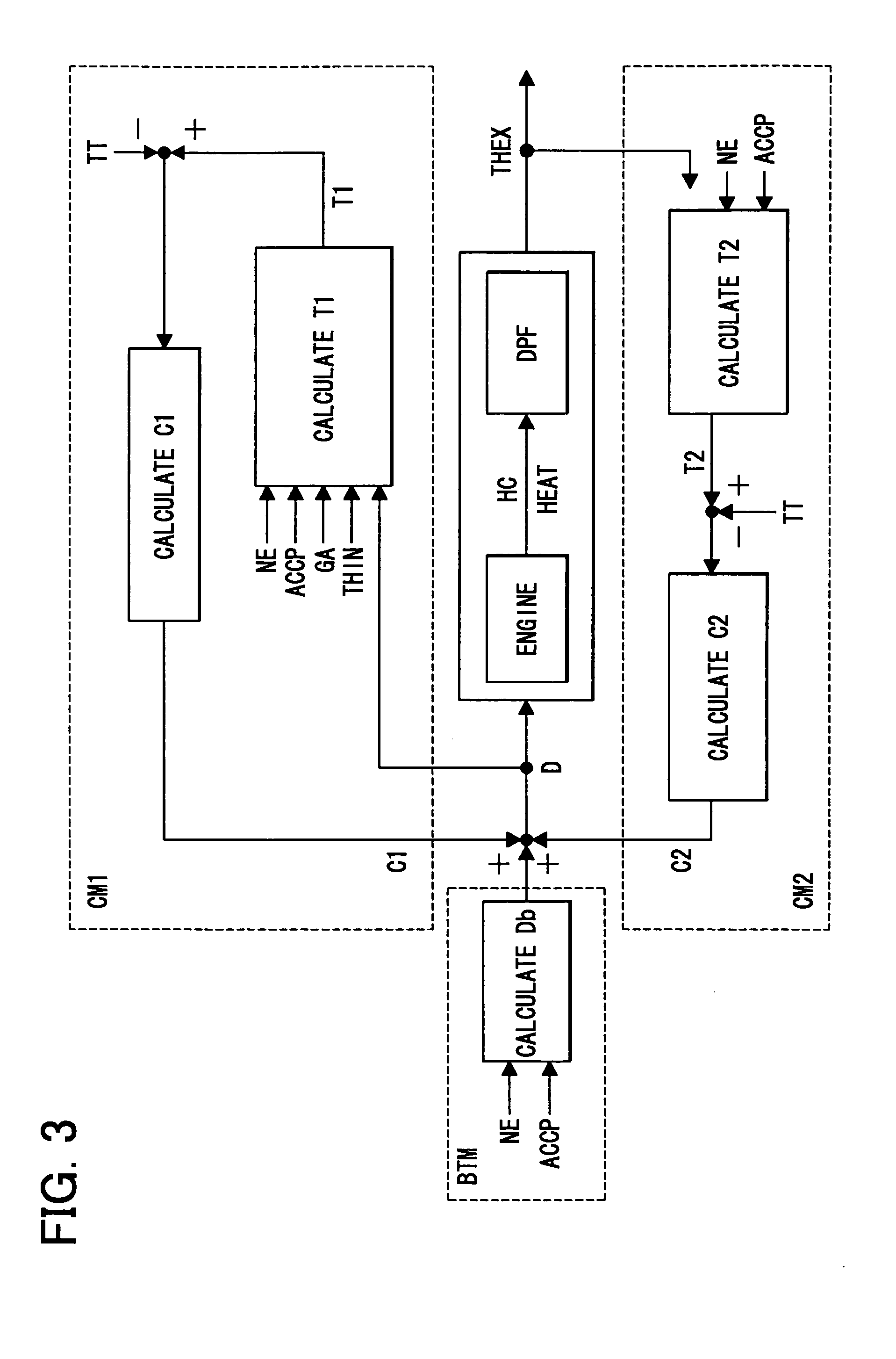Exhaust gas purification system of internal combustion engine
a technology of exhaust gas purification system and internal combustion engine, which is applied in the direction of machines/engines, electrical control, separation processes, etc., can solve the problems of damage to dpf, and degradation of oxidation catalysts supported on dpf, so as to improve controllability and ensure safety , the effect of inhibiting the deterioration of fuel consumption
- Summary
- Abstract
- Description
- Claims
- Application Information
AI Technical Summary
Benefits of technology
Problems solved by technology
Method used
Image
Examples
first embodiment
[0044]Referring to FIG. 1, an exhaust gas purification system of a diesel engine according to a first embodiment of the present invention is illustrated. As shown in FIG. 1, a diesel particulate filter (a DPF, hereafter) 3 is disposed between exhaust pipes 2a, 2b, which provide an exhaust passage 2 of the diesel engine 1. An oxidation catalyst (a diesel oxidation catalyst: a DOC, hereafter) 4 is disposed in the exhaust pipe 2a upstream of the DPF 3. The DPF 3 is a ceramic filter having publicly known structure. For instance, the DPF 3 is formed of heat-resistant ceramic such as cordierite in the shape of honeycomb structure having a multiplicity of cells as gas passages provided by porous separation walls. An inlet or an outlet of each cell is blocked alternately. The exhaust gas discharged from the engine 1 flows downstream while passing through the porous separation walls of the DPF 3. At that time, particulate matters are collected and accumulated in the DPF 3 gradually.
[0045]The...
second embodiment
[0078]Next, regeneration control of the DPF 3 performed by the ECU 6 according to a second embodiment of the present invention will be explained based on a flowchart shown in FIG. 15. Structure of the exhaust gas purification system and a block diagram of a characteristic portion of the DPF regeneration control of the second embodiment are the same as those of the first embodiment. In the second embodiment, target temperature setting means changes the setting of the target temperature TT of the DPF 3 in accordance with the particulate matter accumulation quantity MPM, unlike the first embodiment.
[0079]First, in Step S201, the air intake quantity GA, the pressure difference PDPF across the DPF 3, the upstream exhaust gas temperature sensor output THIN and the downstream exhaust gas temperature sensor output THEX are inputted into the ECU 6. Then, in Step S202, the particulate matter accumulation quantity MPM of the DPF 3 is calculated based on the exhaust gas flow rate QE, which is c...
third embodiment
[0087]Next, regeneration control of the DPF 3 performed by the ECU 6 according to a third embodiment of the present invention will be explained based on FIGS. 16 to 18. Structure of the exhaust gas purification system of the third embodiment is the same as the first embodiment. A block diagram shown in FIG. 16 shows a characteristic portion of the regeneration control of the third embodiment, or the first temperature estimate calculating means of the first correcting means in detail. In the third embodiment, in the calculation of the first temperature estimate T1 from which the first correction value C1 is calculated, the delay in the temperature change with respect to the convergence temperature T0 is divided into dead time and an nth-order delay. The convergence temperature T0 is calculated based on the information related to the area upstream of the DPF 3 including the state of the exhaust gas flowing into the DPF 3, the operating state of the engine 1 and the temperature increas...
PUM
| Property | Measurement | Unit |
|---|---|---|
| temperature | aaaaa | aaaaa |
| temperature | aaaaa | aaaaa |
| temperature | aaaaa | aaaaa |
Abstract
Description
Claims
Application Information
 Login to View More
Login to View More - R&D
- Intellectual Property
- Life Sciences
- Materials
- Tech Scout
- Unparalleled Data Quality
- Higher Quality Content
- 60% Fewer Hallucinations
Browse by: Latest US Patents, China's latest patents, Technical Efficacy Thesaurus, Application Domain, Technology Topic, Popular Technical Reports.
© 2025 PatSnap. All rights reserved.Legal|Privacy policy|Modern Slavery Act Transparency Statement|Sitemap|About US| Contact US: help@patsnap.com



